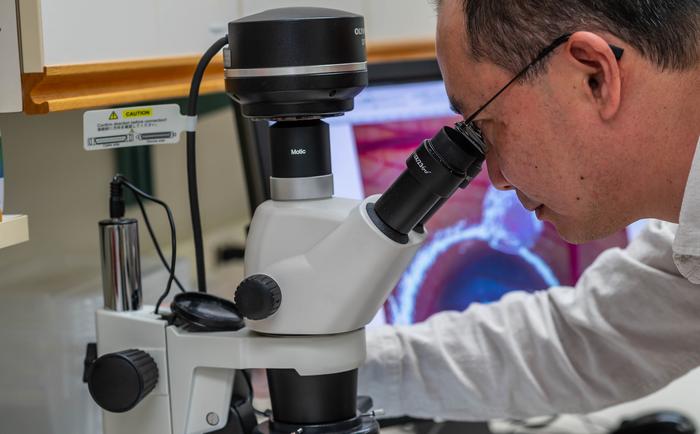A groundbreaking innovation in the realm of pediatric oncology has emerged from a collaborative research effort led by the University of British Columbia and the BC Children’s Hospital Research Institute. This pan-Canadian team’s state-of-the-art technique enables the rapid identification of personalized treatment options for young cancer patients by leveraging an unexpected biological model: chicken eggs. This revolutionary method introduces a novel approach to address the pressing challenge posed by pediatric cancers that resist conventional treatments.
Historically, the care for pediatric cancer patients has largely relied on genomic testing—analyzing the DNA of the cancer cells in order to identify mutations that could be targeted by specific therapies. However, genomic testing alone can sometimes fail to identify actionable treatments, particularly for rare types of cancer. The current study sought to bridge the gap between genomics and proteomics, the study of proteins, suggesting that this combined approach could unveil crucial insights into tumor behavior and provide new, actionable strategies for treatment.
A particular case highlighted by the research involved a patient diagnosed with a rare and aggressive pediatric cancer that had shown a resistance to traditional chemotherapy. After previous attempts to find an effective drug based solely on genomic testing yielded no viable options, the team turned to proteomic analysis. By focusing on the proteins expressed by the tumor, researchers were able to uncover metabolic vulnerabilities that genomics had overlooked.
The integrated use of sertraline, a well-established antidepressant, emerged as a potential treatment. The research team discovered that the cancerous tumor heavily relied on an enzyme known as SHMT2, which is crucial for its metabolic processes. Utilizing sertraline to inhibit this enzyme enabled researchers to target the tumor’s energy sources effectively. This innovative therapeutic application underscores the importance of exploring non-traditional uses for existing drugs in cancer treatment.
To understand how this approach could be implemented in real-world clinical settings, the researchers developed a distinctive experimental model utilizing chicken eggs as hosts for tumor cells. This method, which allows for the growth of a tumor in a simplistic, yet biocompatible environment, serves as an avatar for the actual tumor present in the patient. By cultivating a patient’s tumor within the egg, researchers could assess the tumor’s reaction to potential treatments in a matter of weeks—an invaluable advantage when time is of the essence in cancer treatment.
Previous methodologies often required extensive periods for drug evaluation, leaving patients to wait indefinitely for treatment options. The rapid feedback loop enabled by using chicken eggs accelerates the process of evaluating drug efficacy. In this specific case, the research team was able to confirm the effectiveness of sertraline in targeting the tumor’s metabolism swiftly, illustrating the practical applications of proteomic exploration combined with novel hosting strategies.
Upon presenting their findings to a panel of experts from the PROFYLE initiative, the team affirmed sertraline as the most promising treatment option for the patient at that time. The results showcased this personalized treatment strategy’s potential, resulting in a notable deceleration of the patient’s tumor growth, although it was essential to recognize that the treatment did not yield a complete cure. Indeed, the journey toward effective cancer treatment is rarely linear, and the researchers acknowledge that further investigation into supplementary or alternative therapies is necessary.
The implications of this research extend beyond the confines of a single case; the goal is to adapt and apply this innovative method to other pediatric patients across Canada. The findings illuminate the importance of personalized medicine in pediatric oncology, advocating for approaches that embrace the complexity of cancer biology rather than relying solely on conventional methods.
Overall, the study emphasizes the importance of interdisciplinary collaboration in advancing cancer research, bringing together expertise from various fields to develop innovative solutions for complex health challenges. As the scientific community continues to strive for improved outcomes for children battling cancer, the integration of proteomics and creative experimental models promises to play a pivotal role in reshaping future treatment paradigms.
In conclusion, the combination of genomic insights with proteomic understanding highlights a critical shift in cancer research, one that stands to benefit innumerable young patients in the future. The innovation born from this study instills hope not only in the realm of pediatric oncology but also in the broader spectrum of cancer treatment, paving the way for more adaptive, responsive, and personalized therapeutic strategies.
Subject of Research: Human tissue samples
Article Title: Proteomics and personalized PDX models identify treatment for a progressive malignancy within an actionable timeframe
News Publication Date: 1-Apr-2025
Web References: Access for Kids Cancer
References: EMBO Molecular Medicine
Image Credits: Paul Joseph/UBC
Keywords: Cancer research, proteomics, pediatric oncology, clinical research, drug development.




